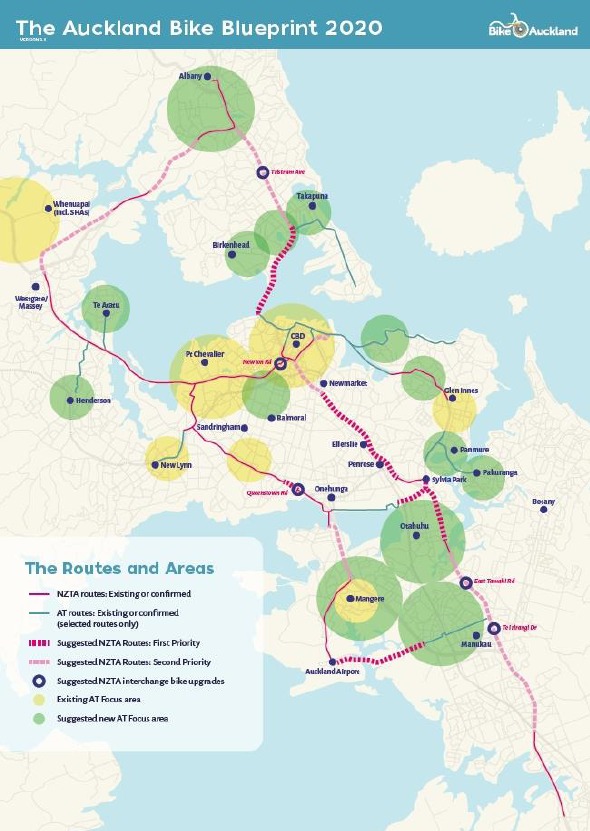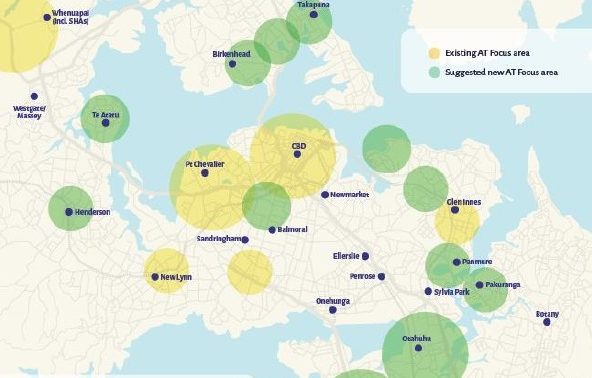The Urban Cycleway Fund has given a huge boost to new bike facilities over the last few years – but its initial 3-year funding period ends in mid 2018. And well before that happens, both Auckland Transport and NZTA will need to have a strong vision of where to go next, and a programme of projects prioritized and ready to go.
That’s why, over the last six months, Bike Auckland has been working behind the scenes on the next tranche of Auckland’s bike infrastructure, 2018-2021.
With an eye to round numbers – and the “vision thing” – we called it the Auckland Bike Blueprint 2020, and have been sharing it with AT and NZTA to help inform their official plans.
If you’ve been to recent Bike Auckland meetings, you may have seen earlier iterations of the Blueprint – but this is the first time we have shown it online. Read on to find out how we developed this vision, and where and why we want to see more cycleways in the next funding period…
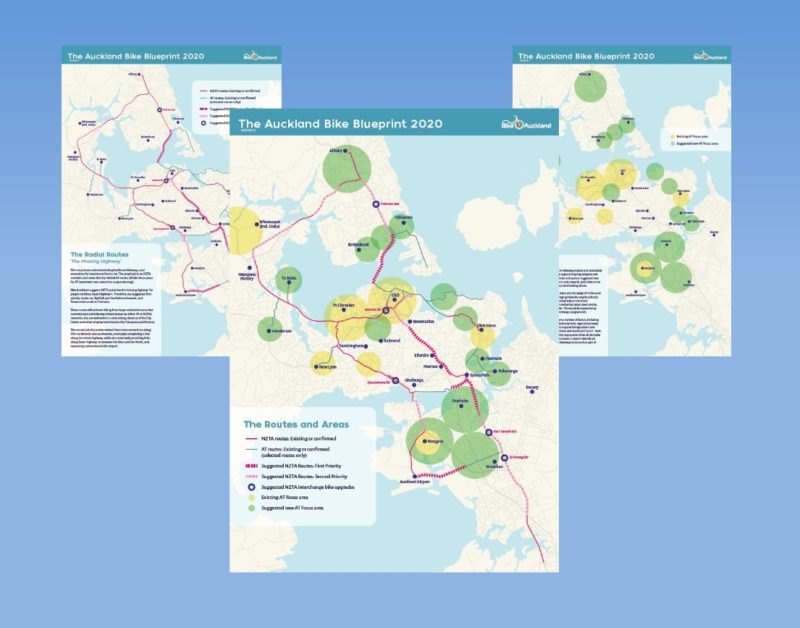
What is the Bike Blueprint?
The blueprint shows Bike AKL’s proposed priorities for Auckland cycling infrastructure over the ~3-5 years from 2018.
These priorities are set out in two key maps: The Routes, which are new key backbone links; and The Areas, which are coordinated approaches to a whole suburb or sector.
What is it not?
It isn’t a citywide network – that’s a much larger and longer project. Rather, it’s parts of the future Auckland cycle network that we think can and should be prioritized in the next funding and building period.
It isn’t everywhere – because if you prioritise everything (much as we’d like to!), you prioritise nothing. And by scattering your investment across the map, you risk not making the kind of measurable difference needed to guarantee more investment. But be assured that as we cut our strategic cloth to fit the vision, questions like “Is this fair?” and “Shouldn’t this area get something?” were some of the most difficult and most hotly debated.
It isn’t Greenways – but we do see Greenways as a smart way over the coming years to ensure bike-friendly changes in areas that are not being prioritized with major chunks of AT or NZTA funding. We’re also alert to local“windows of opportunity” in areas we haven’t prioritized, which can provide unexpected chances for improving cycling as part of unrelated projects.
How did you develop the maps?
We looked at the following key criteria for investment:
- Potential users (employment / residents)
- Gaps & opportunities in the bike network (aiming to Ungap the Map, as our Vancouver mates phrase it)
- Planned housing development & planned transport projects
- Positive feedback loops between the “routes” and “areas”
More on all that as we go through…
So, what are the “Routes”?
Depending on where in the world you are, you might call them “backbones”, “cycle superhighways”, “regional routes” or “metro routes”: a network of high quality paths for longer distances or for high volumes of riders. They can be protected bike lanes, or off-road pathways – like the Northwestern Cycleway, or Tamaki Drive – and together they form the big picture, showing up as big lines on a map of the whole city.
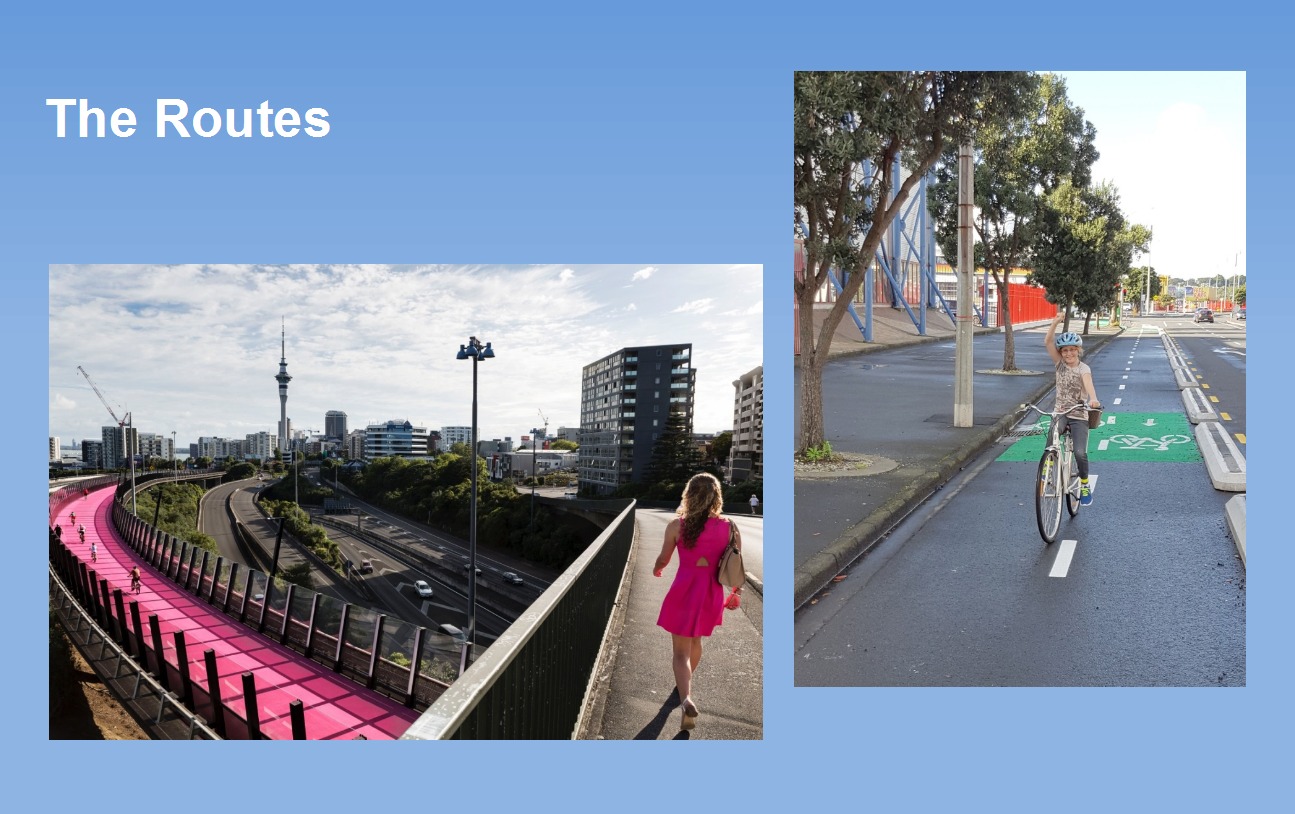 Let’s have a look at our map of existing and proposed Routes:
Let’s have a look at our map of existing and proposed Routes:
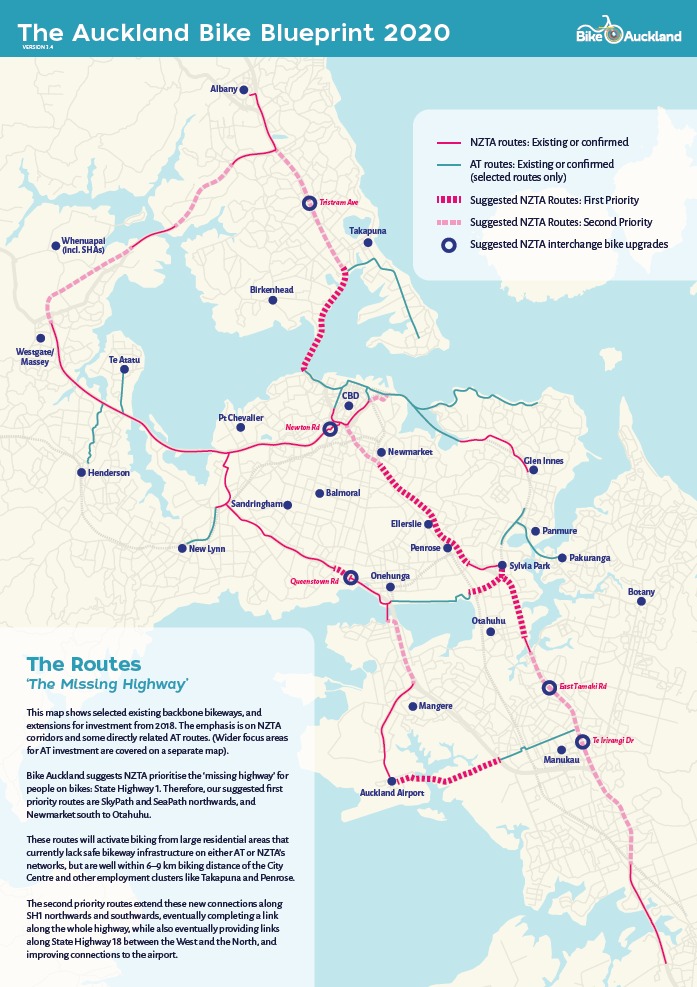
As you can see, most of the existing and proposed routes are along State Highways, i.e. NZTA corridors.
(NB Some AT routes, such as the one to be built along Great North Road, aren’t shown here – for reasons that will become clear when we get to the “Areas” map. We also had to reduce the complexity a bit, which is why confirmed routes – i.e. funded but not built yet, like SH 16-SH 1 near Albany – are depicted as existing routes)
Because the next tranche of investment is not fixed yet, the focus of these maps is to guide and establish priorities at the grand scale. And here we come to the key project we want to see tackled: The Missing Highway.
“The Missing Highway”? Where’s that?
It’s missing… but you can see it plainly on the map! You have the Northwestern Cycleway out west; and a developing ring route that will go almost around the Inner Isthmus, once the eastern cycleway, Te Ara ki Uta ki Tai, is completed.
But there is a big gap in the middle right through the heart of Auckland, along State Highway 1. This is the Missing (Cycle) Highway. And we want to see action there, particularly on these two sections:
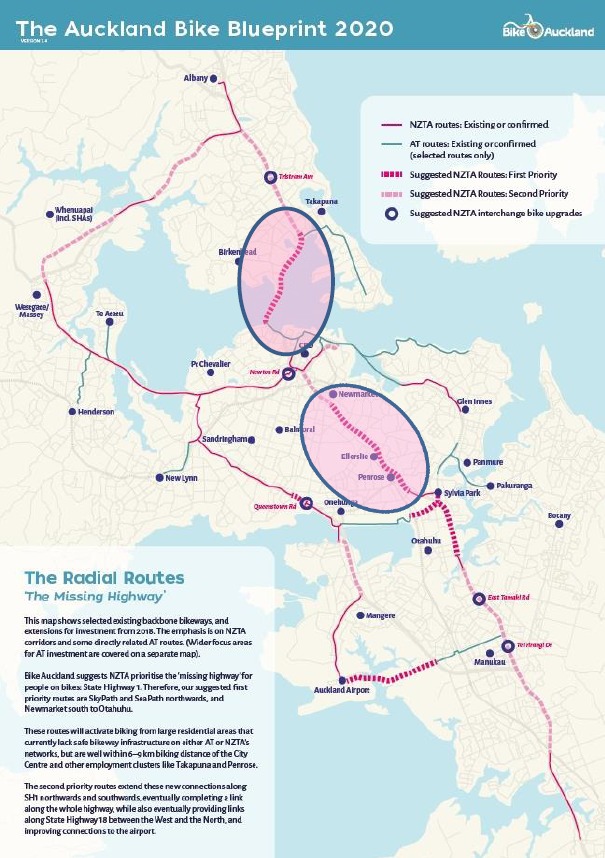 Of course, if you look closely, the northern of those two areas consists of SeaPath and SkyPath.
Of course, if you look closely, the northern of those two areas consists of SeaPath and SkyPath.
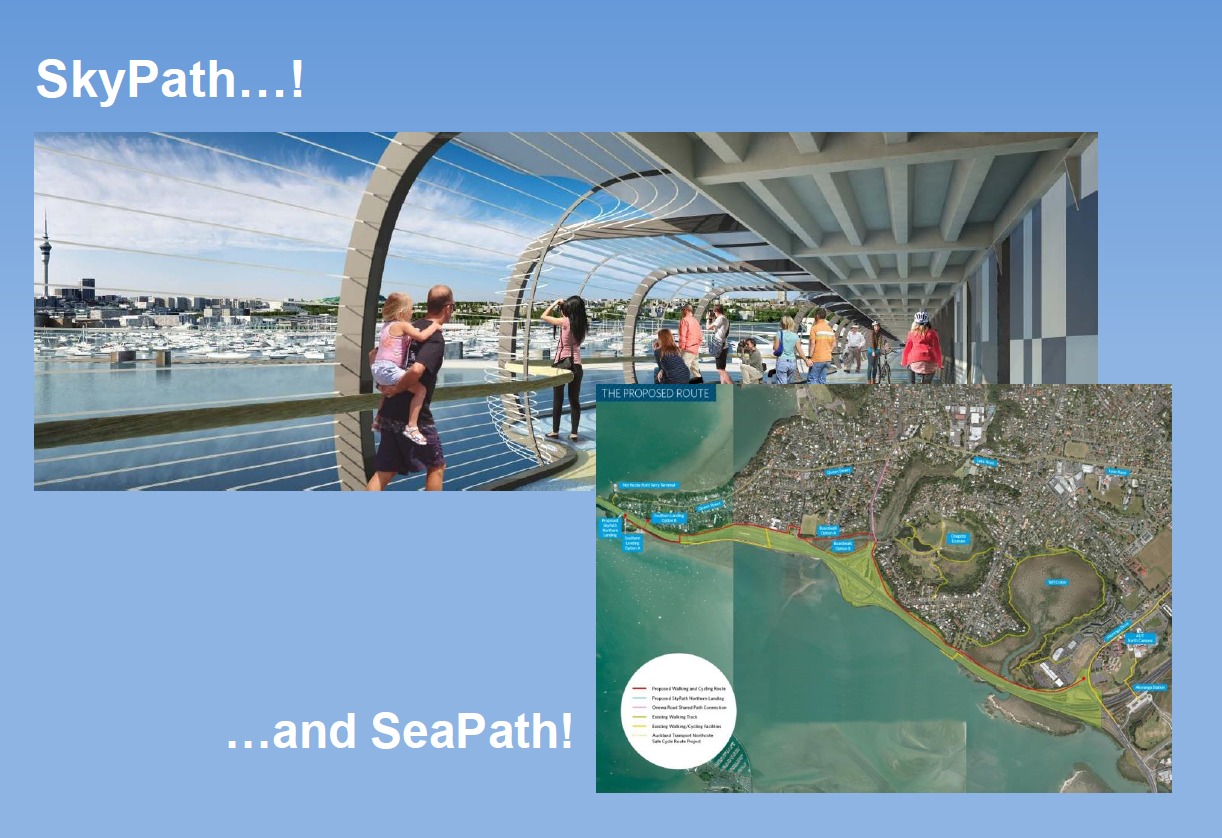 With SkyPath having finally cleared the last major approvals hurdle, the pressure is now on to get these two projects going, and we’ve said as much to AT and NZTA. We feel the case speaks for itself – though we will elaborate a bit more below.
With SkyPath having finally cleared the last major approvals hurdle, the pressure is now on to get these two projects going, and we’ve said as much to AT and NZTA. We feel the case speaks for itself – though we will elaborate a bit more below.
Somewhat less in everyone’s minds, however, is the second part of the “Missing Highway” route, along State Highway 1 southeastwards, from Newmarket to Penrose for starters. This is the Auckland Biking Bermuda Triangle!
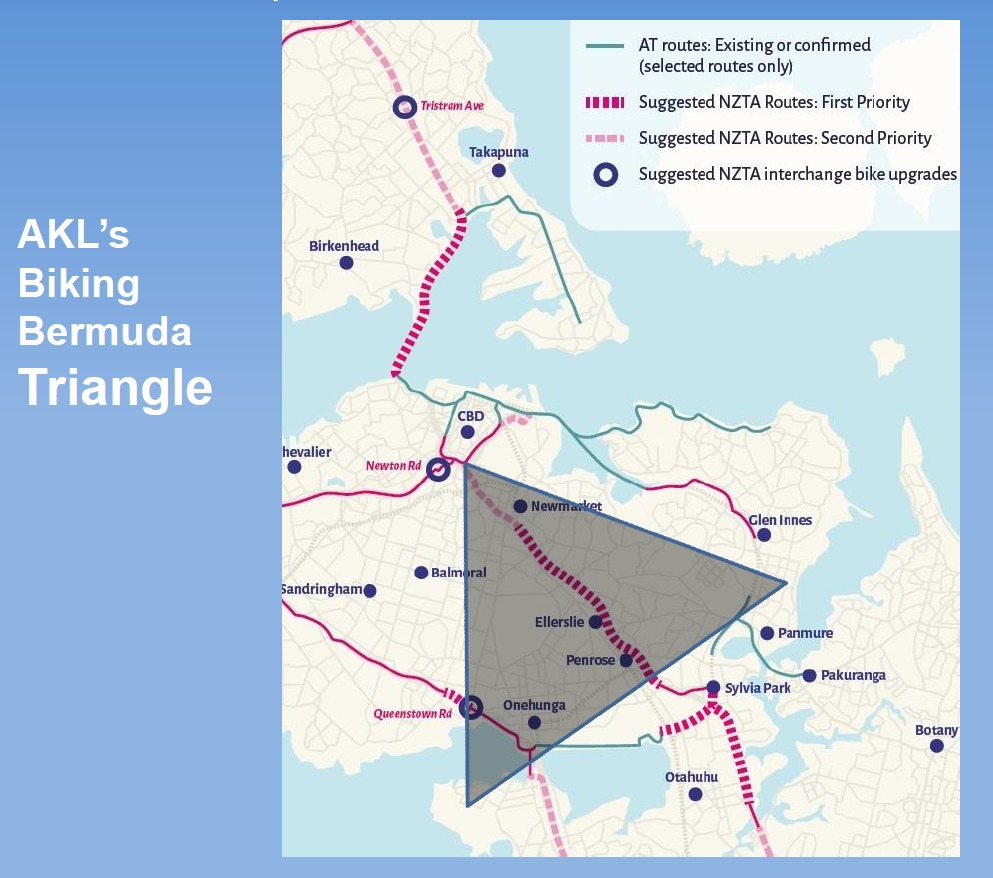 We call it the “Bermuda Triangle” because people on bikes are literally lost, here. There is an enormous level of suppressed demand, with no safe cycle routes at all. Remuera Road? A patchwork of T3 lanes. Great South Road or Manukau Road? Nothing. And nothing like the Northwestern Cycleway as an alternative either.
We call it the “Bermuda Triangle” because people on bikes are literally lost, here. There is an enormous level of suppressed demand, with no safe cycle routes at all. Remuera Road? A patchwork of T3 lanes. Great South Road or Manukau Road? Nothing. And nothing like the Northwestern Cycleway as an alternative either.
So our challenge to authorities is: build a Southern Cycleway, to mirror what SH16 already has, what the east is currently getting, and what SH1 will have on the Harbour Bridge and north of it.
It doesn’t have to run strictly along the motorway corridor – some parts will likely use AT roads, and others will run in the railway corridor.
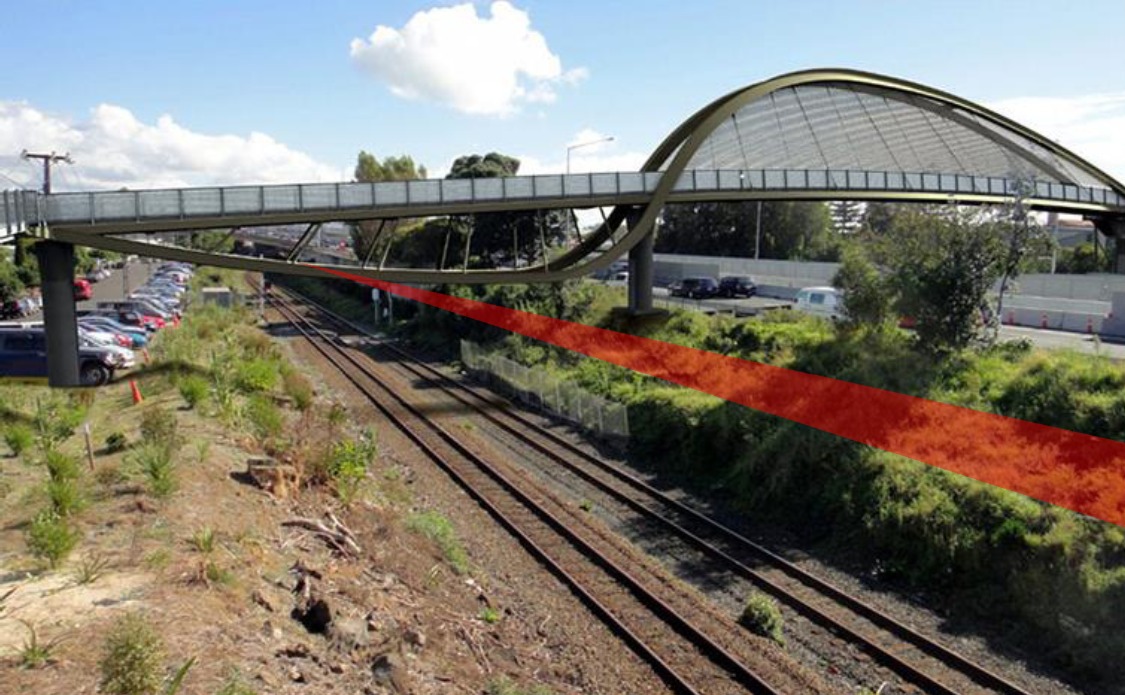 Sure, this project will be a challenge – and it will need to be combined with other bike-friendly improvements in the surrounding areas and streets to ensure it maximises benefits. While we know that AT is currently concentrating hard, elsewhere, we also know that when NZTA decide to really take on a challenging cycle project…
Sure, this project will be a challenge – and it will need to be combined with other bike-friendly improvements in the surrounding areas and streets to ensure it maximises benefits. While we know that AT is currently concentrating hard, elsewhere, we also know that when NZTA decide to really take on a challenging cycle project…
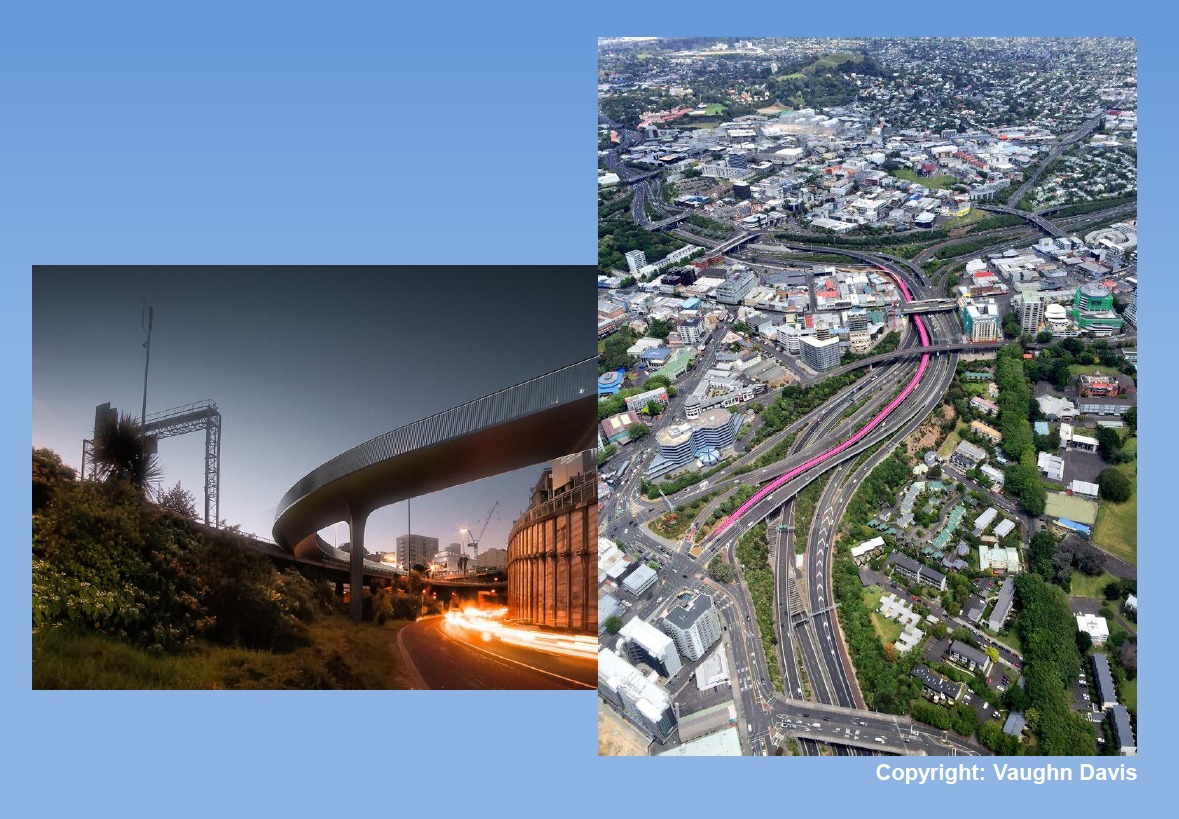 …they tend to do so with verve and style! So we’re calling on them to take the first big step towards building a path through the Bermuda Triangle!
…they tend to do so with verve and style! So we’re calling on them to take the first big step towards building a path through the Bermuda Triangle!
Do these priority routes stack up, budget wise?
In other words, what’s the payoff for these big challenges? Let’s start by looking at where people work. Thanks to Hamish Campbell’s excellent data-viz (“normalising” employee counts from the census data into same-sized geographic cells), we see how the two proposed new routes sit vis-a-vis Auckland’s most job-dense areas…
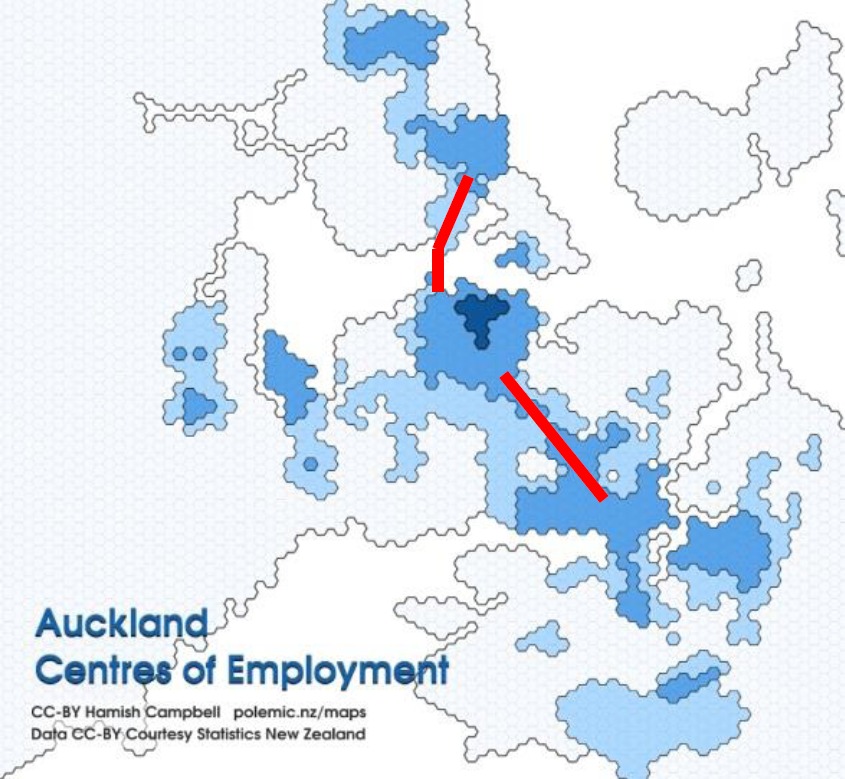 Yes, smack dab linking some of the densest clusters: Takapuna to the City Centre, and City Centre/Newmarket to Greenlane/Penrose. Along the way, there are major residential catchments, full of people ready to hop on and bike to work, or use the routes for work trips between the clusters.
Yes, smack dab linking some of the densest clusters: Takapuna to the City Centre, and City Centre/Newmarket to Greenlane/Penrose. Along the way, there are major residential catchments, full of people ready to hop on and bike to work, or use the routes for work trips between the clusters.
But won’t these just be long-distance bike highways for the electric warriors and weekend sportsters? Not really, as you can see when the routes are overlaid on another map:
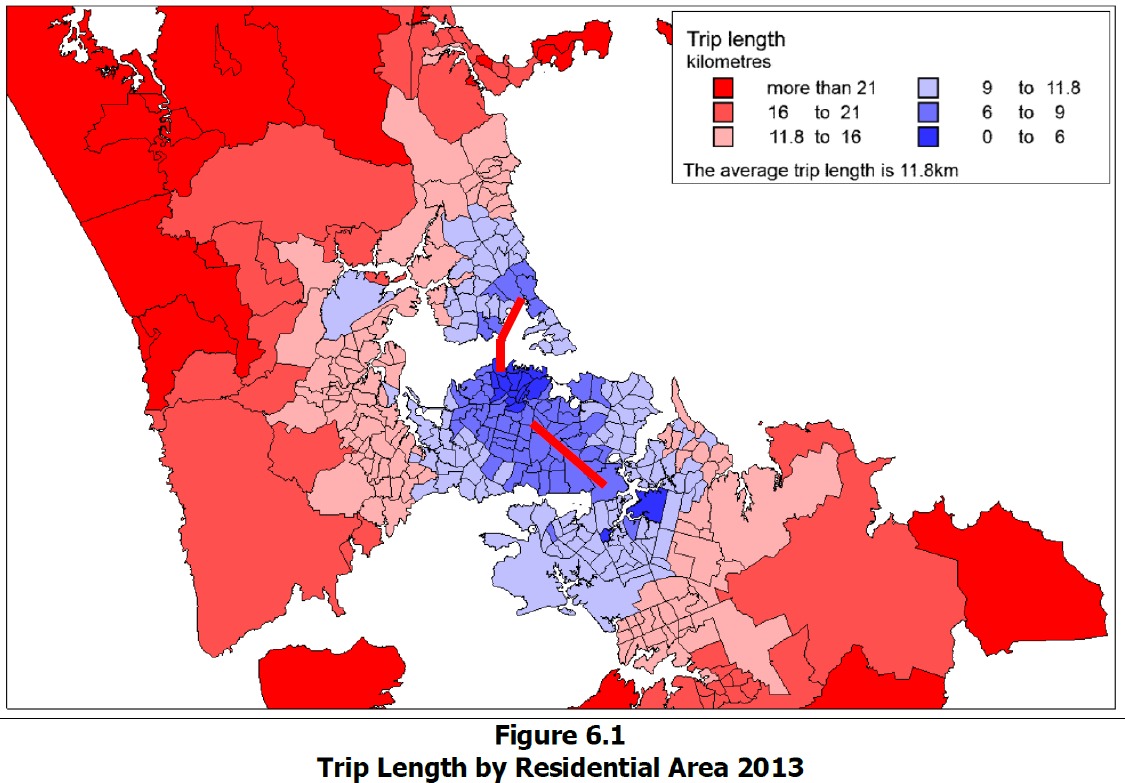 Yup, look at that. The routes actually run right through the sections of Auckland where the average census trip is between 6-9 km on average. That’s a whole lot of potentially bikeable trips, even without e-bike assistance.
Yup, look at that. The routes actually run right through the sections of Auckland where the average census trip is between 6-9 km on average. That’s a whole lot of potentially bikeable trips, even without e-bike assistance.
In sum, we feel that these two routes will tap into a massive suppressed demand for mid-distance cycling, in areas that currently have no good options. Build these routes, and the Shore and the SouthEast Central Isthmus will start booming right away!
Of course, these bikeways are not so useful for getting the kids to school on bikes, or nipping to the shop for a bit of quaxing.
Which brings us to the second part of our Bike Blueprint. The Areas.
So what are the “Areas”?
No big surprise – they’re areas where we want to see cycling improved across a whole neighbourhood. Our approach here is: let’s look at a particular suburb or local area with a logical cohesion, and ask: what needs to be done here to make cycling safe and attractive locally? Making it easier to get to the nearby longer routes, yes – but also, encouraging a quick trip down the road to see friends.
We say, let’s use the whole tool chest – it’s not just about main routes. Of course some of the busier roads in any area will need protected cycle lanes… like in this nice AT image!
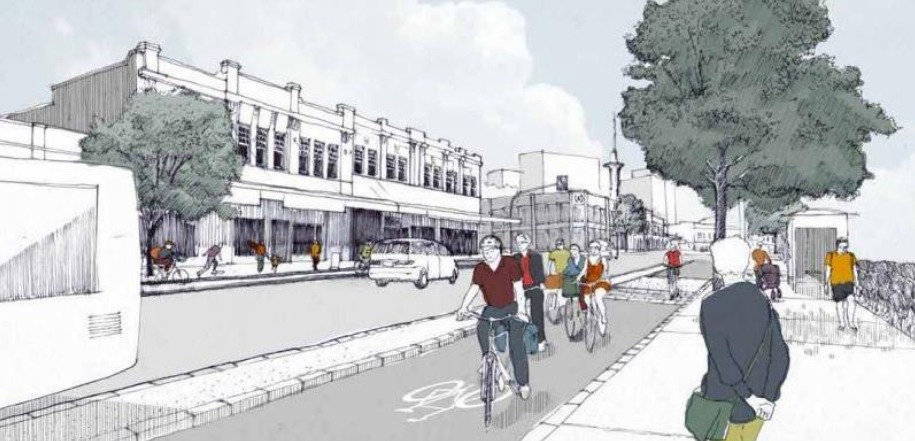 But we’ve specifically held off suggesting individual, specific local routes on our maps, even in areas where there are one or two very obvious and logical candidates. Why? Partly for readability: at Auckland-wide scale, the map would get pretty crowded and bitsy.
But we’ve specifically held off suggesting individual, specific local routes on our maps, even in areas where there are one or two very obvious and logical candidates. Why? Partly for readability: at Auckland-wide scale, the map would get pretty crowded and bitsy.
But more importantly, it’s because we’re talking about more than just local routes, and about more than protected cycleways. Protection is great – but appropriate speeds are the other side of the coin. The key to truly bike-friendly (and people-friendly) neighborhoods is slower speeds, and not the frankly half-pie attempts we’ve been seeing in recent decades, which are really just status quo with a bit of glitter.
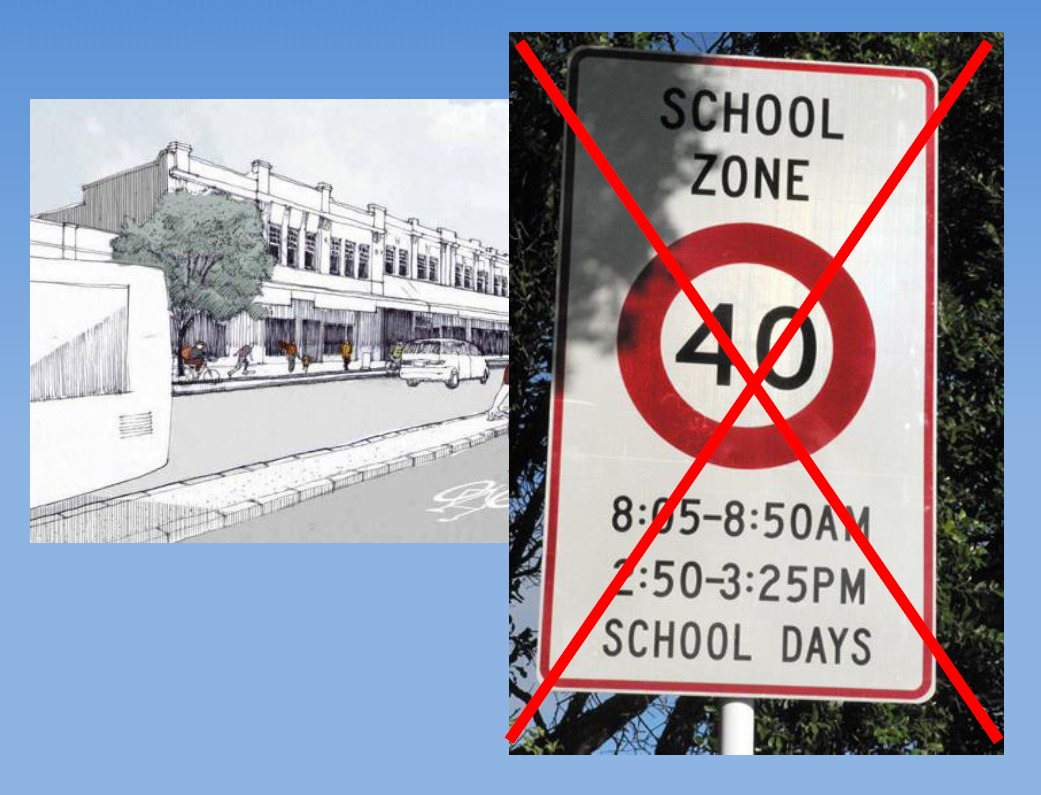 For properly people-friendly residential and town centres, we need more consistently slower speeds – 30 km/h or less for the whole area. Not just near the local school, doled out in quarters of an hour – all day and night, every day. That way, people can get used to the quieter and safer traffic, street design can be permanently adapted, neighbours can start to see streets as places to meet, and kids can play outside or ride to the dairy to spend their pocket money.
For properly people-friendly residential and town centres, we need more consistently slower speeds – 30 km/h or less for the whole area. Not just near the local school, doled out in quarters of an hour – all day and night, every day. That way, people can get used to the quieter and safer traffic, street design can be permanently adapted, neighbours can start to see streets as places to meet, and kids can play outside or ride to the dairy to spend their pocket money.
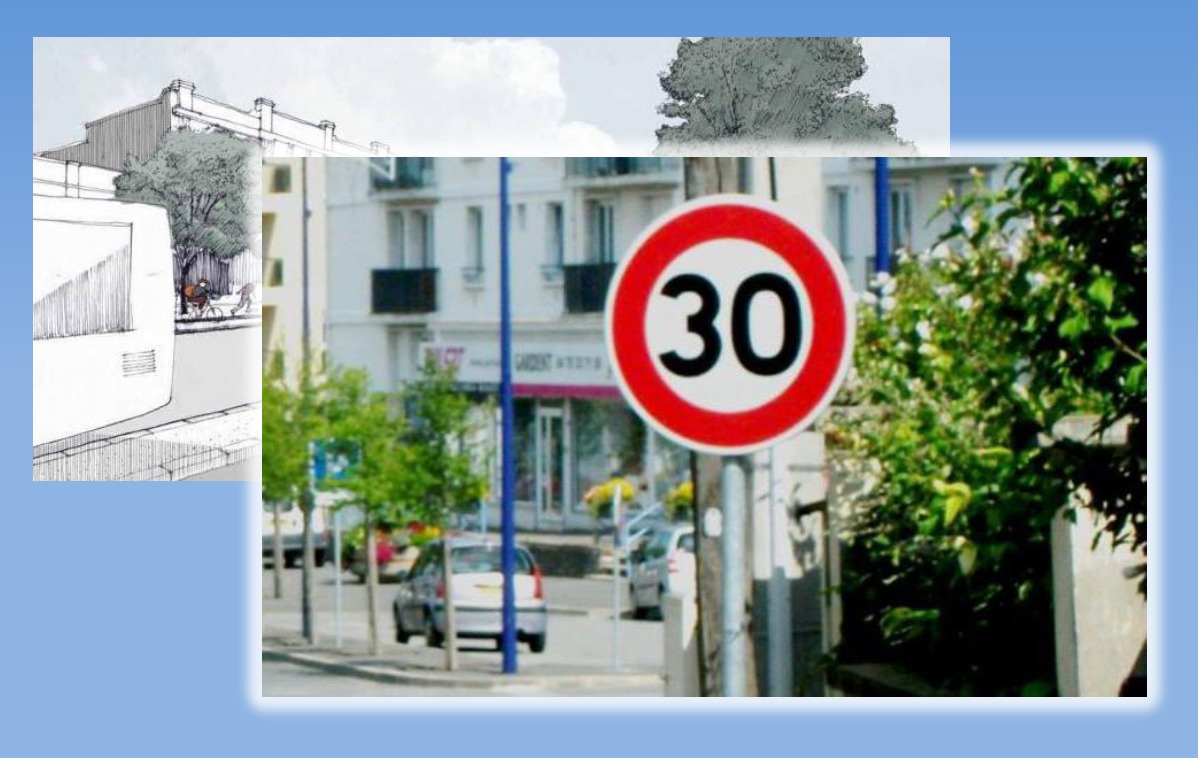 Yes, physical changes will be necessary (would you like another tree on that there build-out, neighbour?) – but these will go hand in hand with a bold, basic decision to slow down a whole area to make it more pleasant and safe, and reclaim neighbourhood streets from being just “rat runs to elsewhere”.
Yes, physical changes will be necessary (would you like another tree on that there build-out, neighbour?) – but these will go hand in hand with a bold, basic decision to slow down a whole area to make it more pleasant and safe, and reclaim neighbourhood streets from being just “rat runs to elsewhere”.
Auckland Transport HAS this power in its hands. Let’s use it actively.
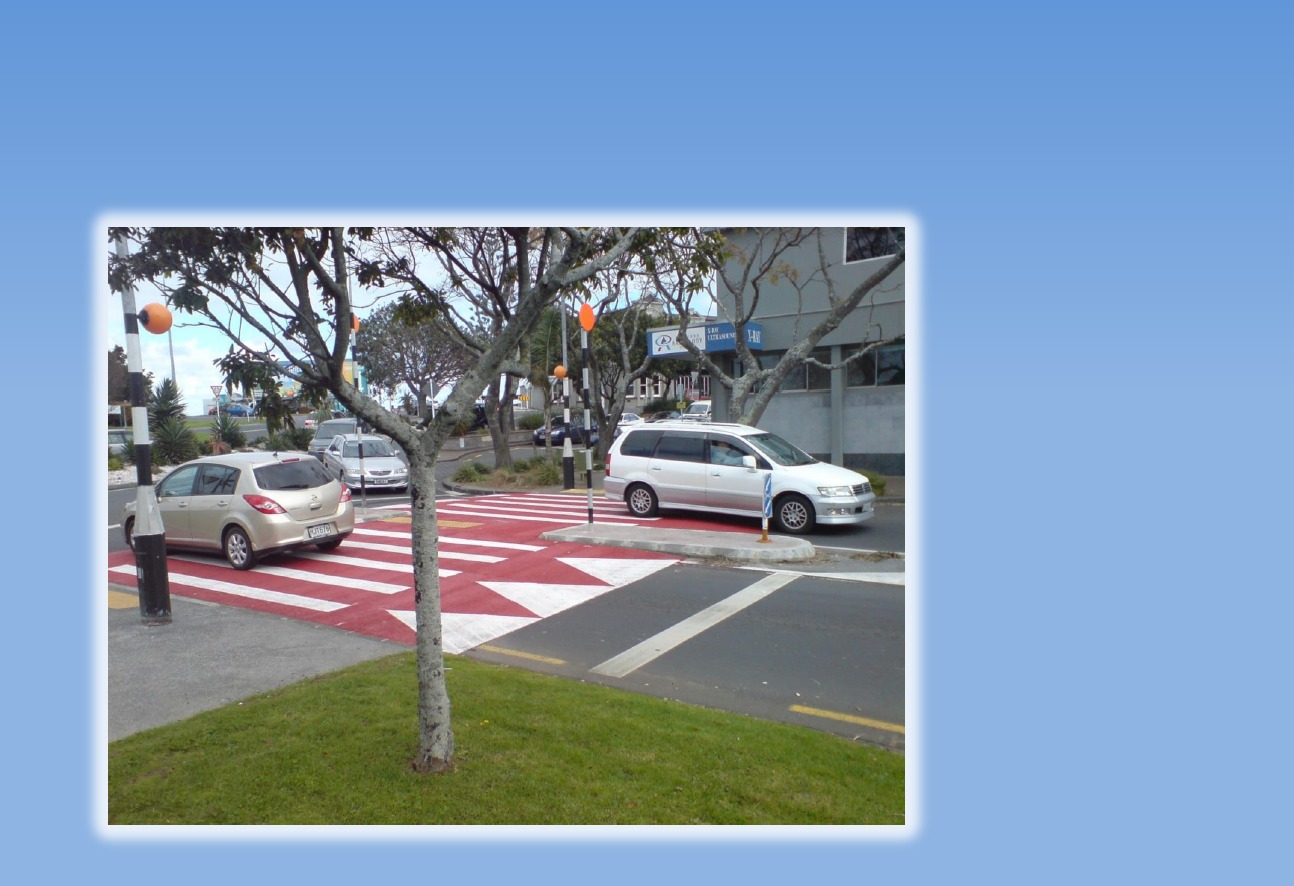
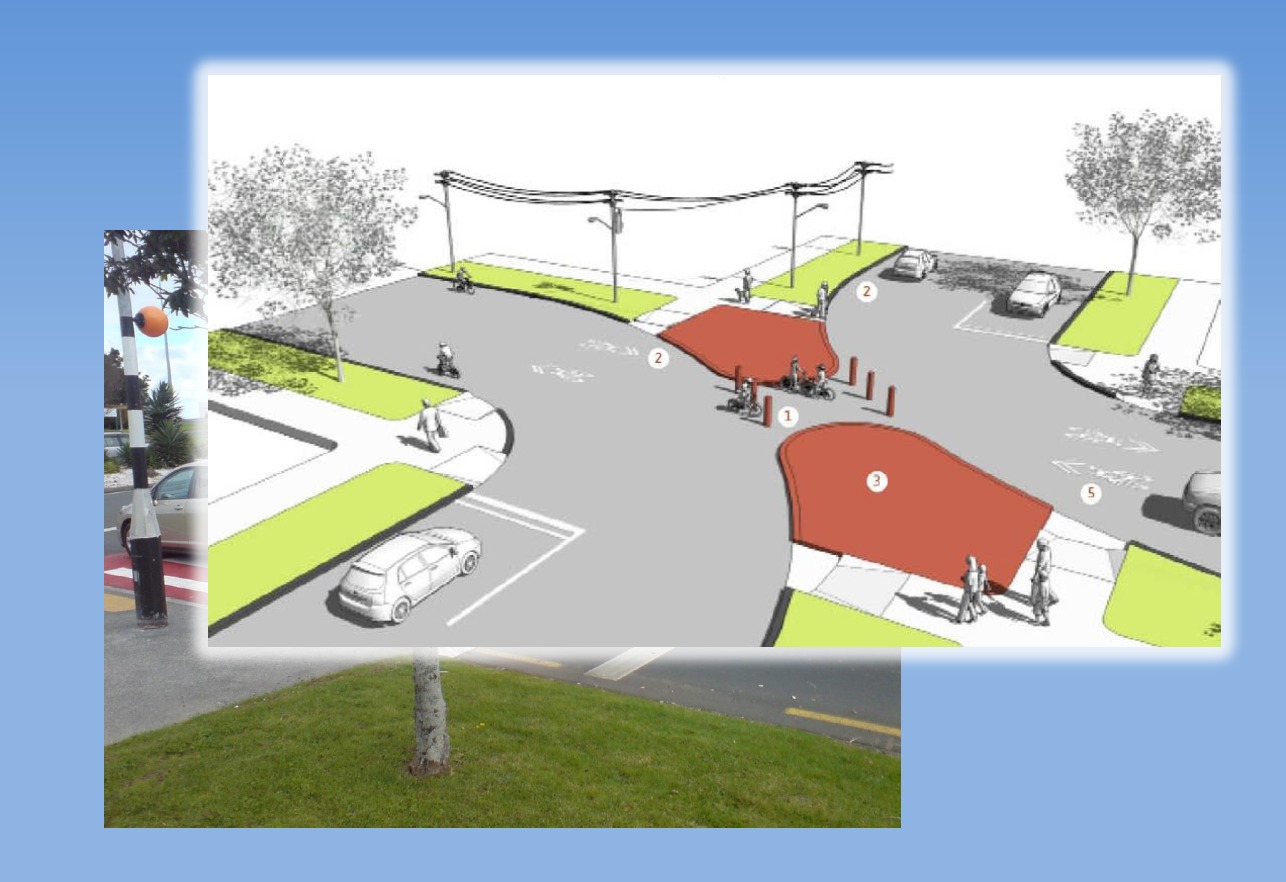 Indeed, we’re already starting to see this more holistic approach being explored in some areas of the city. The City Centre’s slowly spreading network of laneways and shared spaces. Wynyard Quarter becoming more people friendly. The Inner West getting not one cycleway but a whole mesh of routes. The traffic calming of almost all of Herne Bay. This is the right direction. Let’s roll it out to more areas.
Indeed, we’re already starting to see this more holistic approach being explored in some areas of the city. The City Centre’s slowly spreading network of laneways and shared spaces. Wynyard Quarter becoming more people friendly. The Inner West getting not one cycleway but a whole mesh of routes. The traffic calming of almost all of Herne Bay. This is the right direction. Let’s roll it out to more areas.
Okay, we’re sold – so, which areas do you think we should focus on first?
Well, since you asked – we made a second map for that. Below, you can see the areas which already have area focus projects (in yellow), and places we think would be great candidates for the next stage (in green):
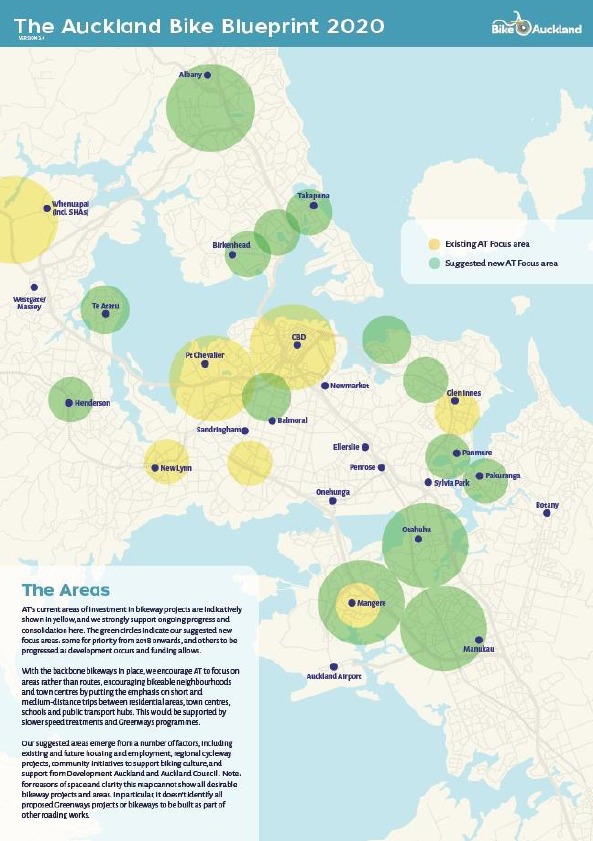
A note on our circular reasoning…
As we developed the maps – which have been brought to life by the very patient and skillful Su Yin Khoo of Extrabold – we discussed long and hard the best way to depict the areas we were talking about.
Often, we wanted a particular area to stretch out juuust a little more in a certain direction, to include something in particular – but not to get too big, etc. So our early iterations were quite, er, biomorphic: there were blobs that looked like kidneys, or other anatomical parts…
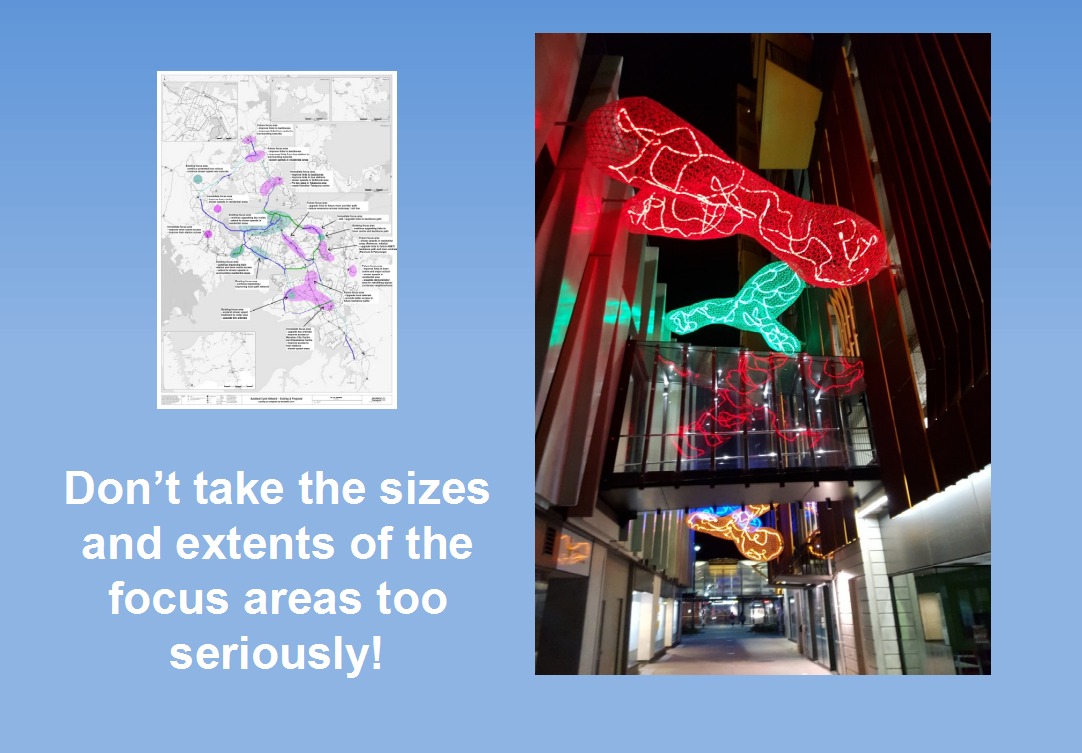
… so for simplicity’s sake, in the end we went back to just circles, in two sizes only: small and large. Which is to say: don’t take the size and edges of the circles too literally, or fret if your street falls just outside a circle: the extents of the “areas” are entirely symbolic.
So what’s up in the yellow areas?
These are the places that already have some level of area-wide improvement happening (or funded and about ready to go). The two biggest focus areas are of course the central ones: City Centre/ Parnell, and the Inner West Suburbs – and we wholeheartedly support them! There’s still a lot to be done, even assuming all the current planned projects are completed by 2018 – but cycling numbers will absolutely take off here, and will set the pace for the rest of the city.
Other, smaller areas with ongoing area projects include Te Ara Mua in Mangere, the Mt Roskill/Puketapapa area with its extensive and growing Greenways network, and the zones around transit hot spots New Lynn and Glen Innes – both of which have various projects planned as part of the Urban Cycleways programme. (We’ll blog more about these as AT starts sharing the plans more widely during 2017).
And the last big area circle covers the various Special Housing Areas in the northwest. Some of these are looking very promising indeed, with protected bike lanes on main streets plus slow-speed back street designs, all cleverly baked into the design from the very beginning. As it should be!
OK, now tell us about those green areas for future investment!
These, we’ve grouped together under a few general headings, based on our reasons for selection.
1. Development Opportunities.
These are places where we suggest cycle investment can and should go hand-in-hand with intensification / housing projects. Big projects bring a lot of attention – and often, lots of road upgrades. So let’s leverage that, and make sure that cycling is included from the get-go, and done well.
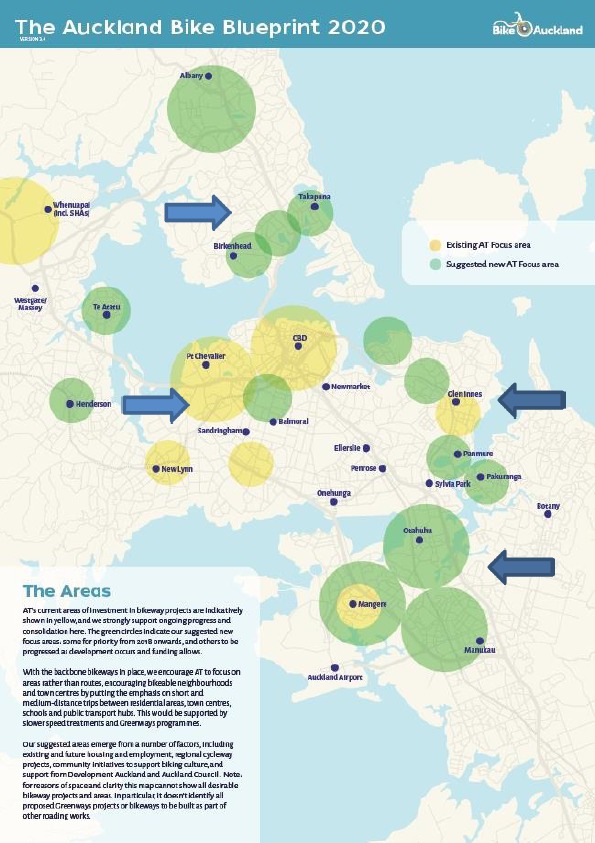
The development areas highlighted with arrows, clockwise from the top:
- On the Shore, the cluster of new housing and revitalised areas planned by Housing New Zealand in Northcote and Development Auckland around Takapuna (these will link well with SkyPath & SeaPath)
- The Tamaki Regeneration Area around Glen Innes and Point England (which is already a “yellow” zone with planned works, but we think needs greater emphasis)
- The Southern Initiative / Development Auckland projects around Manukau City Centre – but also with huge potential for cycling improvements in the neighborhoods to the west and north, especially given the strong developments in Mangere as a bike-friendly burb, and the growing Airport.
- The Unitec Housing Development in Mt Albert, a big new suburb which is intended to be very cycle-friendly (disclosure – the writer is part of the project team for that one)
2. Project Opportunities
These are areas where an existing transport project – often with already some key cycle facilities in the mix – can and should be extended to a wider approach, so as to maximise the investment.
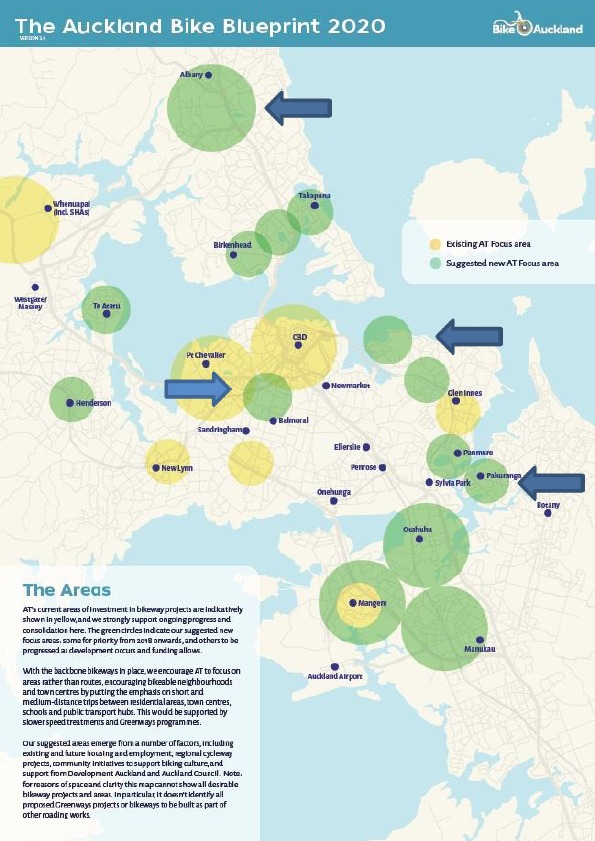
The project areas highlighted with arrows above, clockwise from middle right:
- All the works under way on Tamaki Drive and along the Glen Innes-to-Tamaki Drive path deserve more holistic treatment and better connections. For example, with the new cycleways going in from Ngapipi westward, it’s time to address the deficiencies and unsafe stretches of Tamaki Drive further east (Mission Bay, looking at you!). We also want to see more and better connections to the new path along the rail line, making sure people can safely get to it from adjacent neighborhoods.
- The new cycleways coming as part of AMETI, especially between Panmure and Pakuranga, will similarly call for clever maximising. (Sadly, the overall busway project has been deferred several times now; the only positive is that the cycle facilities get better with every long delayed iteration)
- In the centre of the Isthmus, we are particularly recommending making space for cycling in advance of (and later hopefully as part of) the proposed light rail projects. From discussions with AT, we know this area is one of their biggest potential areas for post-2018 projects (especially the northern part of the area across Sandringham / Dominion Rd / Mt Eden Rd). There’s certainly lots of demand waiting to be unleashed.
- And in the Albany area up north, we have the cycleways proposed along State Highway 1 and 16 for the Northern Corridor, with cycleways along Albany Highway providing the strong local framework. We’d like to see this developed at a more fine-grained local level to attract more people than the longer-distance commuting crew.
3. Burb Opportunities
Two other green areas we’ve put on the map are Te Atatu Peninsula and Henderson. Both have the bones of great cycling suburbs – local enthusiasm, a number of great cycleway links (and/or PT links) already in place, and heaps of potential for growth in local trips and bike-to-other-connections. We’d love to see more projects taking off in these two Westie burbs, and are keen to see them function as “model villages” for future neighborhood-based area projects. (And of course see also Mangere, as mentioned above in terms of development and bike-burb readiness).
Now, let’s zoom back out for a moment…
Same question as with the routes – how do we know these are good areas to invest in bikes?
Where do we get the best “bike for the buck”, you mean? Well, first have a look at where the Unitary Plan now allows for more housing growth (= more people = more people on bikes, and also more demand for travel options):
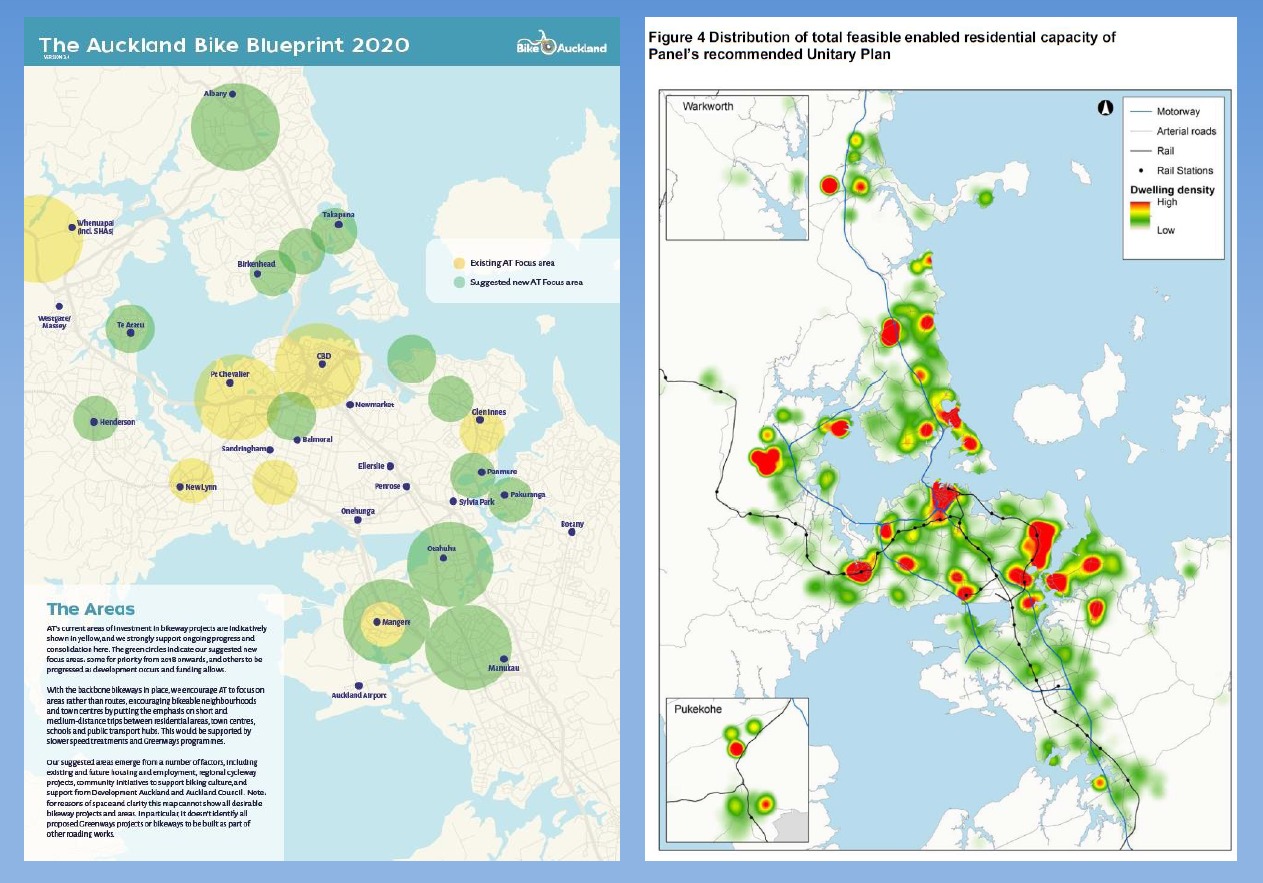
Mmmh, that seems to fit pretty well. You can see the hot spots in the City Centre, Glen Innes-Pt England-Panmure-Pakuranga, Northcote-Takapuna, and Westgate.
But what about our push for bike investment around Manukau, you say? Well, the Unitary Plan heat map above may not show much planned increase in housing density Manukau and nearby, but…
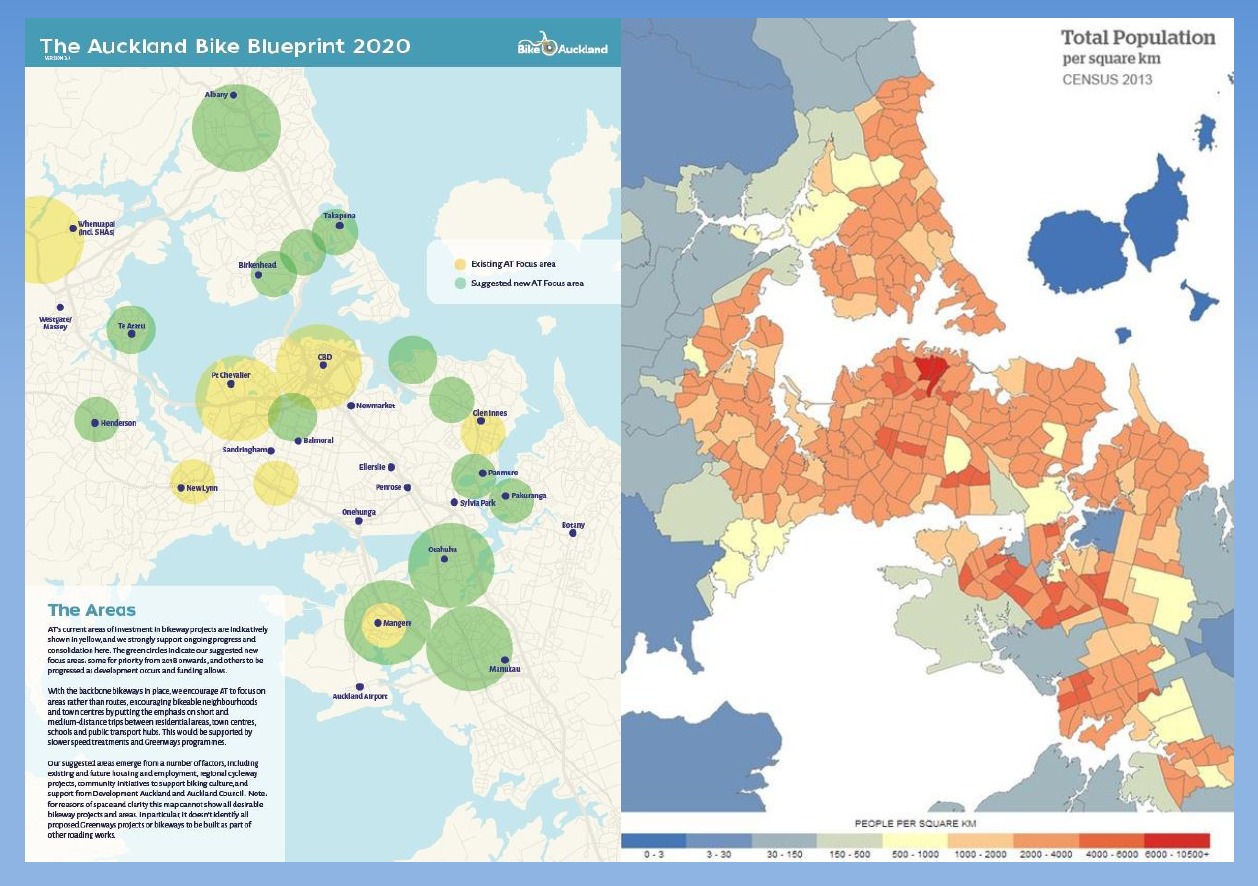
…that’s because it is already one of the most densely populated areas of Auckland! The density level of people living in suburbs like Papatoetoe, Mangere East and Otahuhu is only comparable to the Inner City – so there is a really huge case for investment here. All those communities deserve better ways of getting around than just the car!
And if you do it right, we predict they’ll be as enthusiastic about everyday biking than the pricier burbs closer to the CBD. (Maybe even more so, with the nice flat terrain!)
So, here we are…
The Auckland Bike Blueprint 2020. A strategic vision of Routes and Areas working together in the immediate term to connect, consolidate, and spread bikeability across more and more of the city…
…with a view to generating an even more bike-friendly city as the future unfolds.
We’re working hard to get AT and NZTA behind this vision, so they can get busy planning it and building it over the next three years. Are you in the saddle with us?
